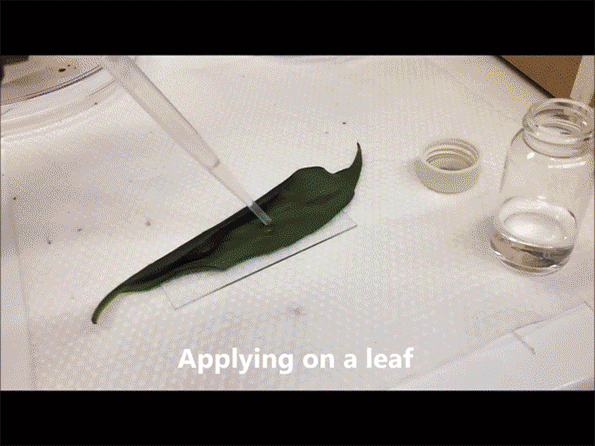Jul 27 2018
MIT researchers have built perhaps the smallest robots yet that can sense their environment, store data, and even perform computational tasks. These devices, which measure about the size of a human egg cell, comprise minute electronic circuits made of 2D materials, piggybacking on tiny particles known as colloids.

Diagram illustrates the design of the tiny devices, which are designed to be able to float freely in liquid or air. (Courtesy of the researchers)
Colloids, which insoluble particles or molecules measuring anywhere from a billionth to a millionth of a meter across, are so tiny they can remain suspended for the foreseeable future in a liquid or even in air. By coupling these minute objects to complex circuitry, the scientists hope to lay the foundation for devices that could be dispersed to perform diagnostic trips through anything from the human digestive system to oil and gas pipelines, or maybe to drift through air to measure compounds inside a refinery or chemical processor.
“We wanted to figure out methods to graft complete, intact electronic circuits onto colloidal particles,” explains Michael Strano, the Carbon C. Dubbs Professor of Chemical Engineering at MIT and the study’s senior author, which was published on 23rd July in the journal Nature Nanotechnology. MIT postdoc Volodymyr Koman is the lead author of the paper.
“Colloids can access environments and travel in ways that other materials can’t,” Strano says. Dust particles, for instance, can float forever in the air as they are small enough that the random motions caused by colliding air molecules are stronger than gravity’s pull. Likewise, colloids suspended in liquid will at no time settle out.
Strano says that while other groups have tried to create similar miniature robotic devices, their focus has been on creating ways to regulate movement, for instance by repeating the tail-like flagella that certain microbial organisms use to thrust themselves. But Strano states that may not be the most productive approach, since flagella and other cellular movement systems are mainly used for local-scale positioning, instead of for major movement. For a majority of purposes, making such devices more functional is more crucial than making them mobile, he says.
Miniature robots built by the MIT team are self-powered, meaning they do not need external power source or even internal batteries. A basic photodiode provides the trickle of electricity that the miniature robots’ circuits require for working their computation and memory circuits. That is sufficient to allow them to sense information about their environment, store those data in their memory, and then later have the data read out after completing their task.
Such devices could eventually be an advantage for the oil and gas sector, Strano says. Presently, the chief way of inspecting for leaks or other issues in pipelines is to have a crew manually drive along the pipe and examine it with expensive instruments. In principle, the new devices could be introduced into one end of the pipeline, transported along with the flow, and then removed at the other end, providing a record of the conditions they come across along the way, including the presence of contaminants that could point to the location of problem areas. The preliminary proof-of-concept devices did not have a timing circuit that would show the location of specific data readings, but incorporating that is part of continuing work.
Likewise, such particles could possibly be used for diagnostic purposes in the body, for instance, to pass via the digestive tract looking for signs of inflammation or other disease indicators, the scientists say.
A majority of conventional microchips, such as silicon-based or CMOS, have a flat, stiff substrate and would not perform well when connected to colloids that can undergo complex mechanical stresses while moving through the environment. Furthermore, all such chips are “very energy-thirsty,” Strano says. That’s the reason why Koman wanted to try out 2D electronic materials, including transition-metal dichalcogenides and graphene, which he found could be linked to colloid surfaces, staying operational even after being introduced into air or water. These kinds of thin-film electronics require only minuscule amounts of energy. “They can be powered by nanowatts with subvolt voltages,” Koman says.
Will it not work to only use the 2D electronics? Without some substrate to transport them, these minuscule materials are too delicate to hold together and work. “They can’t exist without a substrate,” Strano says. “We need to graft them to the particles to give them mechanical rigidity and to make them large enough to get entrained in the flow.”
But the 2D materials “are strong enough, robust enough to maintain their functionality even on unconventional substrates” such as the colloids, Koman says.
The nanodevices they created using this technique are autonomous particles that comprise electronics for computation, logic, power generation, and memory storage. They are driven by light and contain minute retroreflectors that permit them to be easily found after their travels. They can then be researched using probes to get their data. In the continuing work, the MIT team hopes to incorporate communications capabilities to allow the particles to provide their data without requiring physical contact.
Other efforts at nanoscale robotics “haven’t reached that level” of developing complex electronics that are adequately small and energy efficient to be suspended or aerosolized in a colloidal liquid. These are “very smart particles, by current standards,” Strano says, adding, “We see this paper as the introduction of a new field” in robotics.
The MIT research team included Pingwei Liu, Daichi Kozawa, Albert Liu, Anton Cottrill, Youngwoo Son, and Jose Lebron. The study was aided by the U.S. Office of Naval Research and the Swiss National Science Foundation.

Researchers produced tiny electronic circuits, just 100 micrometers across, on a substrate material which was then dissolved away to leave the individual devices floating freely in solution. (Courtesy of the researchers)